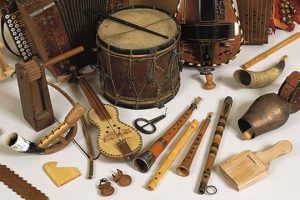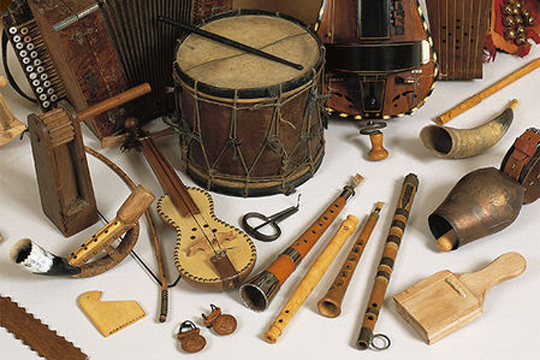Music and singing is such an important part of Basque culture. No Basque festival or party is complete without an accordion or a txistu. And, like all cultures, the Basques have created some of their own unique musical instruments while incorporating others like the accordion that has since become a staple of Basque folk music. And others, like the txalaparta, almost disappeared only to see a revival in recent years. Yet others have been lost to time.

- The alboka is a woodwind instrument made out of an animal horn. It has the unique feature that a second pipe allows for circular breathing and continuous playing. Curiously, while the instrument is native to the Basque Country, alboka is not a Basque word – it comes from the Arabic word al-bûq meaning trumpet or horn. While the current form might be native to the Basque Country, the alboka may have originally been “imported” from Asia, perhaps during the Arab conquest of the Iberian peninsula. It has been mentioned in text at least as far back as the 1400s.
- The dultzaina or bolingozo is another reed instrument brought by the Arabs. It is a double reed instrument, in the same family as the oboe.
- Two instruments that are extremely important to Basque music but which aren’t originally Basque are the tambourine or pandero and the accordion. The accordion is the youngest instrument in the Basque pantheon, introduced only in the 19th century. However, it is now heard everywhere and is a staple of Basque music.
- I’ve written about the txalaparta before. Suffice it to say here that the txalaparta was originally a means of communication between valleys, often to announce cider production. After almost being lost, it has since undergone a revival as an important folk instrument.
- I’ve also written about the txistu before. Often played by one person who also plays a drum, the txistu is one of the most ubiquitous Basque instruments, often accompanying many dances. There is a larger version, the silbote or txistu handia, that requires two hands to play.
- Sometimes, particularly in Zuberoa, the txistu is accompanied by a ttun-ttun, a wooden box with strings stretched tightly across that are then hit with a mallet. Much like a guitar, the strings can be tuned. Variants with between 5 and 10 strings exist. The ttun-ttun is also played in Béarn.
- These are only a few of the instruments that have been used in traditional Basque music. Some, like the zarrabete and the maniura, have been lost, either in the Basque Country and still played elsewhere, or completely with only historic mention. See this article and this article for more details.
A full list of all of Buber’s Basque Facts of the Week can be found in the Archive.
Primary sources: Please see the links in the main text.
Discover more from Buber's Basque Page
Subscribe to get the latest posts sent to your email.



Greetings,
There is a Basque instrument called la Gaita. In 1716, the Navarre government prohibited men and women to dance together when the Gaita was played. This article appeared in the Pays Basque Magazine, Aug, Sept, Oct. 1997. Author. Mixel Esteban. It is in French. Six pages. Good illustrations. Javier Lacunza with a friend revived the instrument. There is a music score . There was a concert of Gaita a Bigorri The address of Pays Basque Magazine : Pays Basque Magazine. B.P. 82,31150, Fenouillet.
I am not savvy with the computer but if anyone is interested to look at the article, I will find someone one to help me send it via e mail or we can work it out.. The photos are super!!
Monique